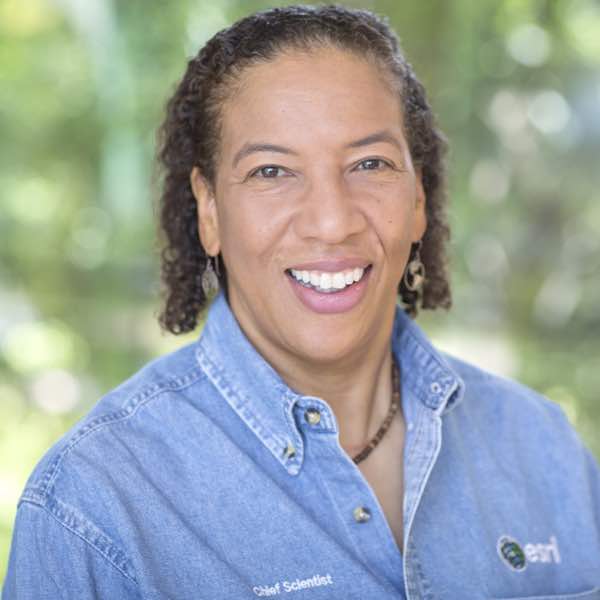One of the ways the Esri science team contributes to scientific ideas and research is by participating in a range of events—many of which happen around the end of each year. Given how 2020 played out, it’s amazing that we all managed to fit everything in, what with so many canceled events being rescheduled for the end of last year. But we did, and here is just a sampling of what we were able to accomplish in the science world during such a busy event season.
Esri always has a significant presence at the annual fall meeting of one of the world’s most respected scholarly earth science organizations, the American Geophysical Union (AGU). In its normal face-to-face form, the AGU Fall Meeting is the largest earth and space science meeting in the world, routinely dwarfing the Esri User Conference (Esri UC) by more than 10,000 attendees. Esri staff always contribute to several scientific papers, posters, and sessions presented at the meeting, and these run the gamut of interesting and important projects. (For more information, read my blog on GeoNet.) Many of these are done in collaboration with Esri’s federal partners at the National Aeronautics and Space Administration (NASA), the National Oceanic and Atmospheric Administration (NOAA), the US Forest Service, the US Department of Energy, the Environmental Protection Agency (EPA), the US Geological Survey (USGS), and several universities and national laboratories. Thus, Esri not only enables greater understanding of the world through its products and services, but it also performs good science and contributes well as a member of the scientific community, sharing and inspiring others with The Science of Where. Esri also always has a sizable exhibition presence at the AGU Fall Meeting, dispensing key messaging and materials and giving demonstrations on topics including multidimensional scientific data and analysis; imagery; big data geoanalytics; the Web GIS pattern; open data; the ecological land and marine units; and several Esri products such as ArcGIS Living Atlas of the World, ArcGIS Pro, and ArcGIS StoryMaps.
As a fairly new associate member of the intergovernmental Group on Earth Observations (GEO), Esri is ramping up its previously steady participation in GEO events. Esri staff members are now taking part in a large number of GEO initiatives, including GEO Blue Planet (which aims to better connect people with information about the oceans and coasts), AmeriGEOSS (a collaborative group for GEO members in the Americas), and Digital Earth Africa (which opens up imagery to users living in and working on issues related to Africa). Esri is also involved with several GEO working groups, including those that deal with capacity development, climate change, and disaster risk reduction. GEO Week 2020, which took place in November, showcased a number of these initiatives. Take a look at some of the recorded discussions and interactive content at GEO Week 2020.
New this season was the United Nations (UN) World Data Forum, which brought together experts and users from a range of data and statistical backgrounds—including in government, the private sector, international agencies, the geospatial community, the media, and academia—to galvanize support for data, encourage innovating with it, and create better ways to use data for sustainable development. Esri staff members and collaborators made significant contributions to sessions that revolved around innovating across data ecosystems and making data available for everyone. Some of the sessions dealt more specifically with gender equality; centralization of geospatial information to improve sustainable development; UN Sustainable Development Goal (SDG) 11, which aims to increase inclusivity, safety, and resilience in urban areas; and mortality tracking during the COVID-19 pandemic.
Another new event—which is smaller in scale but no less important—is the Gulf of Mexico Alliance’s new Virtual Tools Café. It’s a virtual meeting that takes place twice a month wherein dedicated and enthusiastic coastal and ocean GIS specialists and resource managers gather to learn about the latest tools available for monitoring, analyzing, and enhancing the ecological and economic health of the Gulf of Mexico. This is part of a long-standing restoration initiative that started after the infamous Deepwater Horizon oil spill of 2010. Esri is a cosponsor of and frequent presenter at the Virtual Tools Café.
In terms of Esri’s own conferences, the Esri UC is by no means the last event of the year. In the science realm, we hosted our first virtual Imagery Summit in October, which featured sessions on geospatial artificial intelligence (GeoAI), dashboards, dynamic mosaicking, and client-side data processing, as well as visualization and analysis with hosted dynamic imagery layers in ArcGIS Online.
Also in October, we were pleased to assist our colleagues at Esri Canada with their virtual GIS Ocean Forum before hosting our own Ocean, Weather, and Climate GIS Forum in November. At both conferences, a growing community of professionals gathered to share advances in data collection, analysis, and communication of ocean and atmospheric science; climate change science, adaptation, and mitigation; ocean and coastal resource management, conservation, and public safety; hydrographic surveying; and more.
Esri staff members greatly value the opportunity these events afford to tell and retell our story: that ArcGIS is now a Web GIS.
The technology is a comprehensive geospatial platform that can advance science, support research, and induce collaboration at multiple scales by way of spatial analysis, visualization, open data, and science communication:
- For individual researchers, ArcGIS has hundreds of geoprocessing and analysis tools; new capabilities, including 3D voxel layers; content management systems; and numerous apps for field data collection, sharing data, viewing results, and more.
- At the scale of lab workgroups, ArcGIS technology fosters collaboration and data sharing with partners via shareable feature and image services, cloud-based raster processing, big data geoanalytics, and more.
- To stimulate interorganizational collaboration, ArcGIS technology helps research institutes work with one another as well as with federal agencies, such as NASA and NOAA, and national and global initiatives, including GEO and the Earth Science Information Partners (ESIP).
- At the scale of broader citizen engagement, the technology can help communicate science to the broadest of audiences—via ArcGIS StoryMaps, for example, or open web map publishing.
We hope to see you at many of these virtual events in the future. And if you can’t make it to something, perhaps you can at least visit YouTube, where most event recordings are now available for replay. See Esri’s schedule of events, or check out the latest on Twitter by following @gisandscience and @deepseadawn. Many Esri science staff members are also active on LinkedIn.


